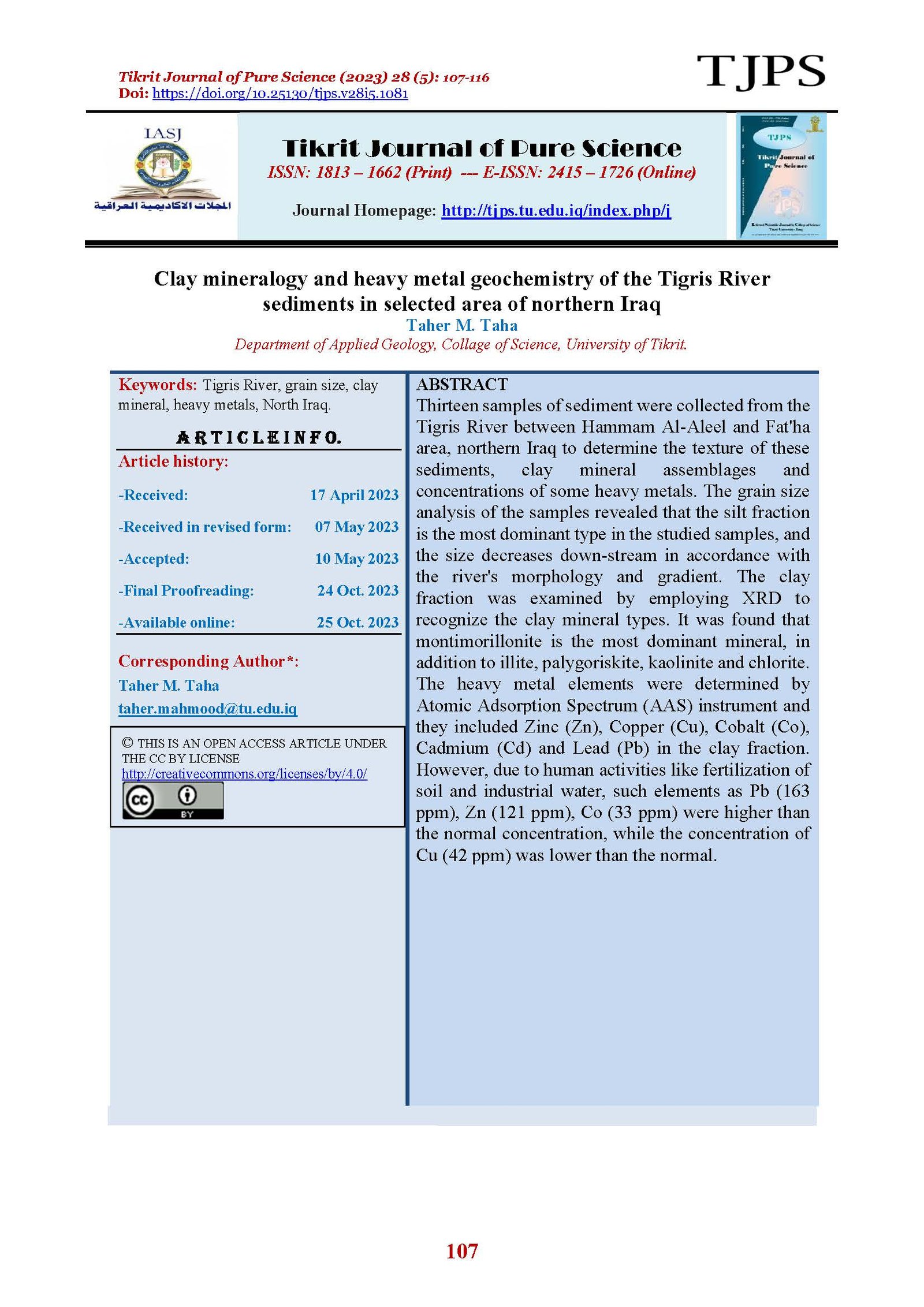Clay mineralogy and heavy metal geochemistry of the Tigris River sediments in selected area of northern Iraq
Main Article Content
Abstract
Thirteen samples of sediment were collected from the Tigris River between Hammam Al-Aleel and Fat'ha area, northern Iraq to determine the texture of these sediments, clay mineral assemblages and concentrations of some heavy metals. The grain size analysis of the samples revealed that the silt fraction is the most dominant type in the studied samples, and the size decreases down-stream in accordance with the river's morphology and gradient. The clay fraction was examined by employing XRD to recognize the clay mineral types. It was found that montimorillonite is the most dominant mineral, in addition to illite, palygoriskite, kaolinite and chlorite. The heavy metal elements were determined by Atomic Adsorption Spectrum (AAS) instrument and they included Zinc (Zn), Copper (Cu), Cobalt (Co), Cadmium (Cd) and Lead (Pb) in the clay fraction. However, due to human activities like fertilization of soil and industrial water, such elements as Pb (163 ppm), Zn (121 ppm), Co (33 ppm) were higher than the normal concentration, while the concentration of Cu (42 ppm) was lower than the normal.
Article Details

This work is licensed under a Creative Commons Attribution 4.0 International License.
Tikrit Journal of Pure Science is licensed under the Creative Commons Attribution 4.0 International License, which allows users to copy, create extracts, abstracts, and new works from the article, alter and revise the article, and make commercial use of the article (including reuse and/or resale of the article by commercial entities), provided the user gives appropriate credit (with a link to the formal publication through the relevant DOI), provides a link to the license, indicates if changes were made, and the licensor is not represented as endorsing the use made of the work. The authors hold the copyright for their published work on the Tikrit J. Pure Sci. website, while Tikrit J. Pure Sci. is responsible for appreciate citation of their work, which is released under CC-BY-4.0, enabling the unrestricted use, distribution, and reproduction of an article in any medium, provided that the original work is properly cited.
References
[1] A. Kabata-pendias and A. B. Mukherjee, Trace Elements from Soil to Human. Berlin: Springer-Verlag Berlin Heidelberg, 2007.
[2] M. G. Vijver, J. Spijker, J. P. M. Vink, and L. Posthuma, “Determining metal origins and availability in fluvial deposits by analysis of geochemical baselines and solid – solution partitioning measurements and modelling,” Environ. Pollut., vol. 156, no. 3, pp. 832–839, 2008, doi: 10.1016/j.envpol.2008.05.028.
[3] S. K. A.-S. Mahmood H. D. Al-Kubaisi, “Evaluation of the Suitability of the Euphrates River water for Drinking and Irrigation purposes in Haditha City, Western Iraq,” Tikrit J. Pure Sci., vol. 27, no. 6, pp. 51–57, 2022.
[4] E. O. Joshua and O. A. Oyebanjo, “Distribution of Heavy Minerals in Sediments of Osun River Basin Southwestern Nigeria,” vol. 1, no. 2, pp. 74–80, 2009.
[5] M. E. A. Mondal, H. Wani, and B. Mondal, “Geochemical signature of provenance, tectonics and chemical weathering in the Quaternary flood plain sediments of the Hindon River, Gangetic plain, India,” Tectonophysics, vol. 566–567, pp. 87–94, 2012, doi: 10.1016/j.tecto.2012.07.001.
[6] M. A. z. and F. S. S. Hamza N.M., Lawa F.A., Yagoub S.Y., “State Establishment of Geological Survey and mineral investigation,” Baghdad (Internal Report), 1990.
[7] A.-B. H. . and A. A. . Jamil A.K., “Hydrogene sulphid pollution of Tigris river –iraq,” iraqi J.of Sci, vol. 26, 1985.
[8] B. T, “Regional Geology of Iraq StratIgrapgy and Paleogeography,” State Organ. Miner. Baghdad, p. 455, 1980.
[9] S. F. A. Fouad, “TECTONIC MAP OF IRAQ , SCALE 1 : 1000 000 ,” Iraqi Bull. Geol. Min., vol. 11, no. 1, pp. 1–8, 2015.
[10] D. . Mange, M.A.and Wright, Heavy Minerals in use, 1st ed. Italy., 2007.
[11] G. Nichols, Sedimentology and Stratigraphy, 2nd editio. Uk, 2009.
[12] Kadhim L. S. Taka A. S. and Alawi J.H, “pollution of Tigris river sediment between Hammam Al-alal and Baghdad,” Eng., Sci. J. Tikrit, vol. 6, no. 4, 1999.
[13] D. Carroll, “Clay Minerals, A Guide to their X-Ray identification,” Geol. Soc. Am. Spec. Pap., no. 126, p. 80, 1970.
[14] G. Brindly, G.W., and Brown, Crystal structures of clay Minerals and their X-ray identification, vol. 5. London, 1980.
[15] A. I. Al-Juboury, “Natural Pollution By Some Heavy Metals in the Tigris River Northern Iraq,” Int. J. Environ. Res., vol. 3, no. 2, pp. 189–198, 2009.
[16] P. Velde,B.and Barre, Soils, Plants and Clay Pollution. 2010.
[17] A. Velde, B.and Meunier, The Origin of Clay Minerals in Soils and Weathered Rocks. Springer-Verlag Berlin Heidelberg., 2008.
[18] R. . Fairbrige, The Encyclopedia of Geochemistry and Environmental Sciences. Van Nortrand Reinhold Company, 1972.
[19] J. . Rose,A.W., Hawkes, H.E. and webb, Geochemistry in mineral exploration, (2nd ed.). Academic press, 1979.
[20] K. . Pendias, Trace Elements in Soil and Plants, 4th ed. Tylor and Frances Group, 2011.
[21] H. M. Hasan, “Determination of the Zinc level in Environmental and Biological Samples in Baiji City by Atomic Absorption Spectrophotometer,” Tikrit J. Pure Sci., vol. 27, no. 4, pp. 47–50, 2022.
[22] J. S. Hawkes, H.E and Web, Geochemistry in mineral exploration. , Harper and Row Co., 1962.
[23] M. D. Bonito, “Trace elements in soil pore water: a comparison of sampling methods,” in Ph. D., University of Nottingham, 2005, p. 263.
[24] V. . Goldschmidt, Geochemistry. London: Oxford University Press, 1954.
[25] L. Jia ,L., Wang,W. Yonghua, L . and Yang, “Heavy Metals in Soil and Crops of an Intensively Farmed Area:A Case Study in Yucheng City, Shandong Province, China,” J. Environ. Res. Public Heal., vol. 7, pp. 395–412, 2010.
[26] M. Aubert, H. and Pinta, Trace Elements in Soils, Developments in soil science,. Amsterdam: Elsevier scientific publishing Co, 1977.
[27] K. H. Turekian, K. K. and Wedepohl, “Distribution of the element in some major unite of the earth crust,” Geol. Soc. Am. Bull, vol. 72, pp. 175–192, 1961.
